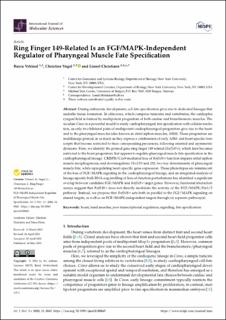Ring Finger 149-Related Is an FGF/MAPK-Independent Regulator of Pharyngeal Muscle Fate Specification
Journal article, Peer reviewed
Published version

Åpne
Permanent lenke
https://hdl.handle.net/11250/3074297Utgivelsesdato
2023-05-16Metadata
Vis full innførselSamlinger
Originalversjon
International Journal of Molecular Sciences. 2023, 24 (10), 8865. 10.3390/ijms24108865Sammendrag
During embryonic development, cell-fate specification gives rise to dedicated lineages that underlie tissue formation. In olfactores, which comprise tunicates and vertebrates, the cardiopharyngeal field is formed by multipotent progenitors of both cardiac and branchiomeric muscles. The ascidian Ciona is a powerful model to study cardiopharyngeal fate specification with cellular resolution, as only two bilateral pairs of multipotent cardiopharyngeal progenitors give rise to the heart and to the pharyngeal muscles (also known as atrial siphon muscles, ASM). These progenitors are multilineage primed, in as much as they express a combination of early ASM- and heart-specific transcripts that become restricted to their corresponding precursors, following oriented and asymmetric divisions. Here, we identify the primed gene ring finger 149 related (Rnf149-r), which later becomes restricted to the heart progenitors, but appears to regulate pharyngeal muscle fate specification in the cardiopharyngeal lineage. CRISPR/Cas9-mediated loss of Rnf149-r function impairs atrial siphon muscle morphogenesis, and downregulates Tbx1/10 and Ebf, two key determinants of pharyngeal muscle fate, while upregulating heart-specific gene expression. These phenotypes are reminiscent of the loss of FGF/MAPK signaling in the cardiopharyngeal lineage, and an integrated analysis of lineage-specific bulk RNA-seq profiling of loss-of-function perturbations has identified a significant overlap between candidate FGF/MAPK and Rnf149-r target genes. However, functional interaction assays suggest that Rnf149-r does not directly modulate the activity of the FGF/MAPK/Ets1/2 pathway. Instead, we propose that Rnf149-r acts both in parallel to the FGF/MAPK signaling on shared targets, as well as on FGF/MAPK-independent targets through (a) separate pathway(s).
